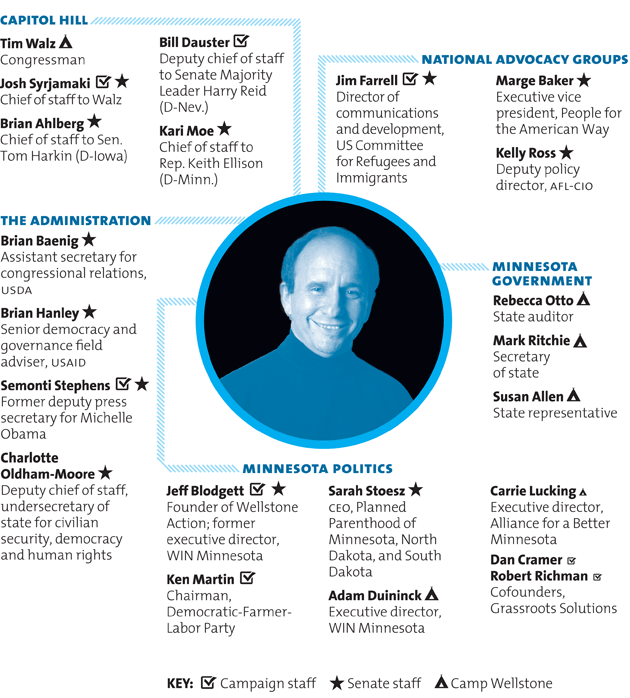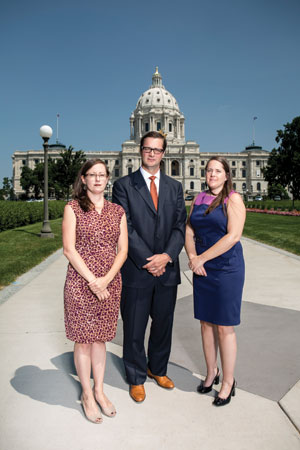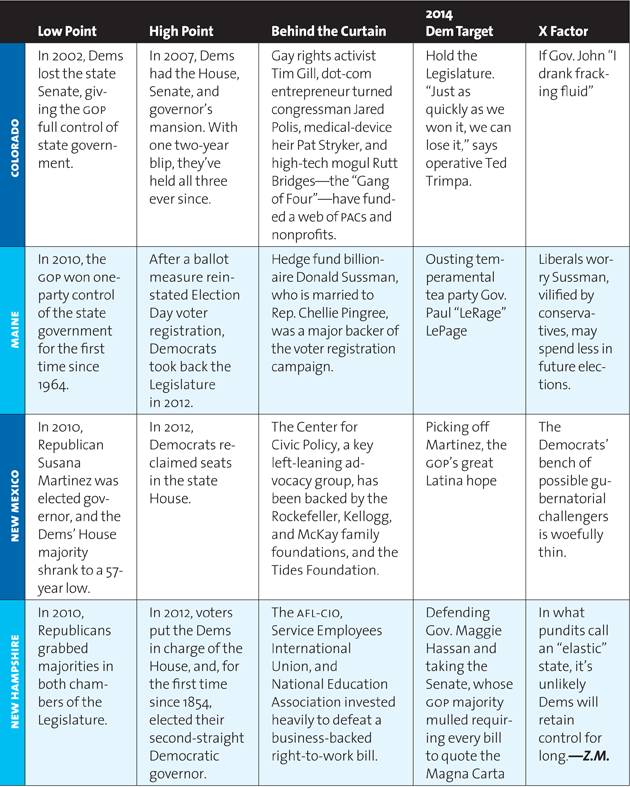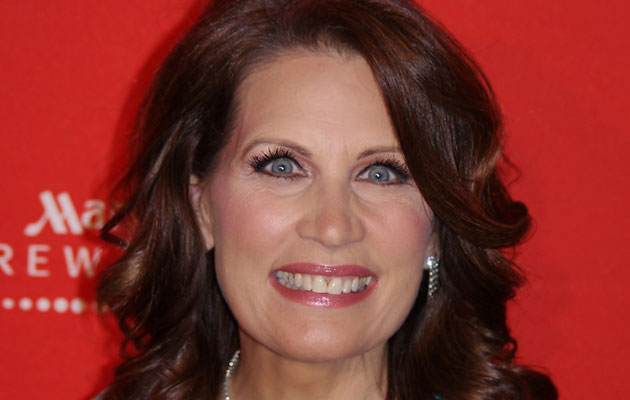
It was the Friday before Memorial Day, and nearly 50 of Minnesota’s most powerful businessmen and Republican operatives met for lunch at the Town and Country Club, overlooking the Mississippi River in western St. Paul. They had gathered at the invitation of Tom Rosen, who runs the nation’s fifth-largest beef-processing company, and Stan Hubbard, the billionaire media magnate who pioneered satellite television. Over Caesar salad and tomato-basil soup, Rosen, Hubbard, and their friends bemoaned the direction of their state. As one after another rose to speak, the tone was one of outrage and incredulity: “It’s time we coordinate.” “It’s time we stand up and do something.” “We’re getting chewed up!”
How far has the GOP fallen from the days when Minnesota was Karl Rove’s prime example for the cascade of blue states poised to turn red and create a permanent Republican majority? A decade ago, Tim Pawlenty was governor, Norm Coleman had replaced the late Paul Wellstone in the US Senate, and Rove was touting Minnesota—which hadn’t voted for a Republican president in 37 years—as a battleground state. Today, Democrats control the state Legislature. They hold both US Senate seats, five of the state’s eight congressional seats, and every constitutional office—governor, lieutenant governor, attorney general, secretary of state, and state auditor. In November, they defeated ballot measures to ban same-sex marriage and enact restrictive voter ID rules. And to top it all off, Rep. Michele Bachmann, the tea party torchbearer under investigation for ethics violations, announced in May that she would not seek reelection. “If you look at the history of our party since 1944, we’re at the apex of our political power,” gushes Ken Martin, the chairman of what in Minnesota is known as the Democratic-Farmer-Labor (DFL) Party.
They’ve not been shy about using that power. Last spring, Gov. Mark Dayton signed bills legalizing gay marriage, creating Minnesota’s Obamacare health insurance exchange, allowing public colleges to freeze tuition, and investing $174 million into pre-K and all-day kindergarten. Dayton and his Democratic colleagues erased a $627 million budget deficit by hiking taxes on smokers, car rentals, and the wealthiest 2 percent of Minnesotans. At the same time, they cut property taxes for middle-class families. It was the most liberal legislative session anyone could remember—and a nightmare for the guests at Rosen and Hubbard’s luncheon. “It was a big wake-up call,” Hubbard told me in June at his St. Paul office, where a framed letter from Ronald Reagan hangs next to a replica of the Declaration of Independence.
Minnesota’s liberal revival may seem like an outlier considering the conservative resurgence in state capitols. Two decades ago, Republicans had one-party control in just three states, while Democrats ran the show in 18. But today 31 states have GOP governors, and in 24 of those, Republicans control both branches of government, compared to 13 for the Democrats. Right next door to Minnesota, Wisconsin is a particularly vivid example: In a onetime bastion of progressivism, Gov. Scott Walker and the Republican Legislature have targeted unions and public servants, shuttered abortion clinics, and passed a rigid voter ID law. “They’re talking about transvaginal ultrasounds and all that shit,” says Denise Cardinal, a Minnesota operative who runs the ProgressNow network of liberal advocacy groups. “We’re talking about raising taxes on the rich and paying back our school debt.” For that Minnesotans can thank—or blame—a small, press-shy circle of operatives, activists, donors, and party leaders who have built a political machine that chugs year-round to elect Democratic candidates and pass progressive policies. It is fueled by big unions and wealthy donors, the best data in the business, and an unusual level of collaboration among organizations that have very different priorities. Their strategy has created a road map for Democrats from Concord to Santa Fe. “The next phase for the progressive movement has to be taking our states back,” says Jeff Blodgett, a 30-year veteran of Minnesota politics who was the Obama campaign’s state director in 2008 and 2012.
This is the story of how that happened—for now—in Minnesota. And it begins in the worst imaginable way.
2002-04: It Can’t End Like This
Blodgett began the longest day of his life feeling like a winner. The date was October 25, 2002. In 12 days, Minnesotans were poised to send Blodgett’s boss, Paul Wellstone, to Washington for a third term. No one, save maybe the senator himself, wanted a Wellstone win like Blodgett did.
The two men met at Carleton College in 1979 when Blodgett was a student in Wellstone’s Poli Sci 10 course. More than a decade later, after Wellstone had traded the campus for the campaign trail, he hired Blodgett to manage his quixotic, shoestring bid for the US Senate. Against the odds, and thanks in part to an early version of the data-centric, get-out-the-vote-focused campaigning that later took Barack Obama to the White House, Wellstone won. The organizer-turned-senator became a liberal icon; Blodgett was his flinty, soft-spoken protégé, a wunderkind later nicknamed the “Yoda of Minnesota politics.”
Blodgett steered Wellstone to victory again in 1996, and almost six years later, as the senator, his wife, Sheila, his daughter Marcia, and three campaign staffers boarded a Beechcraft King Air A100 to attend a funeral, Blodgett set his mind to the day ahead—a debate in Duluth, a rally with actor Josh Hartnett in St. Paul. But the Beechcraft never arrived, crashing south of Eveleth and killing everyone on board.
Blodgett was shattered. He pulled himself together enough to recruit former Vice President Walter Mondale to run in Wellstone’s place, but Norm Coleman, a onetime campus radical turned Republican rising star and Rove acolyte, eked out a 2-point win. After the election Blodgett was unemployed and adrift. He turned over the same thought in his head: It can’t end like this. “If we didn’t have Paul and Sheila around,” he recalled some years later, “we had to figure out the next best thing.”
The next best thing became Wellstone Action, an organization conceived by Blodgett to train candidates, campaign managers, and activists to win elections the “Wellstone way”—promising bold policy ideas, investing heavily in grassroots organizing, and forging diverse coalitions. In May 2003, Wellstone Action held its first Camp Wellstone, a two-and-a-half-day crash course in campaigns and elections, and in the ensuing years 55,000 people would graduate from these trainings. Of the 112 DFL lawmakers elected to the Legislature last year, 40 were Camp Wellstone alums. US Rep. Tim Walz and Secretary of State Mark Ritchie graduated from the same Camp Wellstone class in 2005.
In a way, Blodgett had kept Wellstone’s spirit alive, bottling up his teachings and tactics and spreading them far and wide. He didn’t know it then, but the groundwork for Minnesota’s progressive comeback was being laid.
WellsTone’s Web
Breaking down the cadre of organizers, operatives, and politicians nurtured by the late senator’s grassroots machine. —Zaineb Mohammed

Josh Syrjamaki, Blodgett’s earnest young deputy on the 2002 campaign, was also looking for a way to carry on Wellstone’s legacy. Raised by a single mom, he met Wellstone at the state fair and signed up for an internship on the spot, rising to become Wellstone’s point man for key supporters, including farmers and veterans. The year after Wellstone’s death, he took a job with the United Steelworkers as the union, along with other liberal groups, put all it had into defeating George W. Bush’s reelection bid via a $145 million get-out-the-vote operation, America Coming Together. Built outside the Democratic Party apparatus after the 2002 McCain-Feingold law banned unlimited soft money contributions to political parties, ACT was envisioned as a full-time machine, a complement to campaign operations that go poof after Election Day. If campaigns were tents—built in a hurry, lived in for a while, then folded up and packed away—ACT was going to be a house.
In the end, ACT, too, folded after failing to send John Kerry to the White House. But Syrjamaki and his boss at the Steelworkers, a taciturn former steel mill worker named David Foster, clung to the idea. The DFL had been bogged down by its grueling nomination process, which often left Democrats battling until the August primaries, while Republicans had all summer to get a head start. And with Wellstone gone, the progressive machine he’d built “just disappeared,” Syrjamaki says.
They turned to Jim Farrell, the spokesman on Wellstone’s 2002 campaign, who had since gone toe-to-toe with the Terminator—fighting a series of anti-union ballot measures backed by California Gov. Arnold Schwarzenegger. Deploying a fusillade of attack ads and a corps of motivated volunteers, the Alliance for a Better California, where Farrell was a senior adviser, had prevailed over a powerful governor and tons of corporate cash. With an eye on the 2006 governor’s race, Syrjamaki and Foster wanted to replicate Farrell’s strategy to bloody up Tim Pawlenty while the Democrats hashed out their choice. In late 2005, Foster filed papers creating the Alliance for a Better Minnesota (ABM).
With Foster guiding Minnesota’s new progressive attack dog, Syrjamaki took the lead organizing the boots on the ground via the state chapter of America Votes, an umbrella organization through which advocacy groups could share data, plot strategy, and harness their money and grassroots muscle for elections and issue campaigns.
Minnesota progressives had tried teaming up before, forming pop-up groups and loose alliances, but usually those efforts fizzled. “It would end up being more expensive and less effective,” says Jon Grebner of the American Federation of State, County, and Municipal Employees. But America Votes and ABM would end up getting traction—thanks, in good part, to a key new ingredient: money.
2005-07: Alida’s Awakening
When she was five years old, Alida Messinger was told by her father that she needed three piggy banks: one for savings, another for spending, and a third for giving away. John D. Rockefeller III knew a thing or two about money: His grandfather was John D. Rockefeller, the founder of Standard Oil and one of the wealthiest men to ever walk the earth.
Since the age of 21, Messinger has given away millions and millions of dollars to causes ranging from environmental conservation to reproductive health. But as she grew alarmed at the direction of her state under Pawlenty and her country under George W. Bush, Messinger began to see her wealth as a means to fight back.
Around that time, a Democratic operative named Rob Stein was jetting around the country meeting confidentially with wealthy donors and showing them a PowerPoint presentation he’d titled “The Conservative Message Machine and Money Matrix.” It laid out the infrastructure of the conservative movement, a web of think tanks, advocacy groups, media watchdogs, candidate recruiting efforts, legal foundations, magazines, and more. The cost to fund such a network: $400 million. “Man, that’s all it took to buy the country?” was the reaction of one incredulous donor.
Stein’s message was simple: Conservatives didn’t have any special secrets. They just played the game better. “I made the case that we need to get better organized,” he told me, “because right now we suck.” In 2005, Stein and others created the Democracy Alliance, an exclusive network of wealthy liberal donors committed to building “movement infrastructure.” Messinger, who’d known Stein for years, didn’t join the Democracy Alliance right away—she was more focused on Minnesota. To that end, she was intrigued by an effort in Colorado to create a state-level version of the Democracy Alliance. So she flew to Denver to meet with Al Yates and Ted Trimpa, the two strategists who’d created the Colorado donor network that backed a constellation of think tanks, candidate-training outfits, blogs, and more. Inspired and emboldened, she returned home and launched WIN Minnesota, another group of liberal donors that soon became the primary funder of the Alliance for a Better Minnesota and a key bankroller of Minnesota’s permanent political machine.
Messinger, now in her 60s, rarely speaks to the media and declined to be interviewed for this story. In the past decade, she has donated more than $10 million to Democratic causes, becoming a George Soros-esque bogeyman to conservatives. “It’s ironic,” says Brian McClung, a GOP operative who worked in Tim Pawlenty’s administration. “The money of the 19th-century titans is being used to beat up on businesses.” But Messinger is more than just a checkbook. She has spoken at meetings of the Committee on States, an obscure outfit that she and other donors use to share strategies for winning in the states. “They are spreading a gospel,” Stein says of donors such as Messinger.
2008-10: “We Have No Other Choice”
Ken Martin wants to talk history. We’re sitting in his corner office at the Democratic-Farmer-Labor Party’s headquarters, surrounded by the ephemera of campaigns past—a framed “Wellstone!” yard sign, a Pride flag planted in an empty coffee mug, a neon-orange hunting cap emblazoned with the name of 2006 gubernatorial candidate Mike Hatch. Martin is wearing a blue blazer, khakis, and loafers, and he bears a passing resemblance to John Travolta.
The collaboration among Minnesota progressives, he says, dates back to 1944, when Hubert Humphrey, then a staffer on FDR’s presidential campaign, brokered a merger between the hapless Democrats and the radical Farmer-Laborites. Not that it has always been a breeze getting the coterie of left-leaning groups operating in Minnesota to act in unison.

In the past, says Martin, groups such as the Sierra Club and Planned Parenthood rarely coordinated. “Let’s say your political program was a mail and door canvass, and let’s say Sierra Club’s program was a mail and door canvass. So you’d be sending a piece of mail to Joe Blow, I’d be sending a piece of mail to Joe Blow, and we’d be knocking Joe Blow, too. That’s not very efficient.” America Votes, he says, “helps to bring everyone together, have everyone talk about what their political plans are, identify where we can create efficiencies, and where there’s holes that still remain.”
Even McClung, the former Pawlenty staffer, concedes that the close collaboration has made Minnesota’s progressives brutally effective. “They have mastered the concept of discipline and cohesion in a way that you really don’t see with Democrats all that often,” he says.
“There’s kind of an art and a science to it,” Jeff Blodgett explains. “The art is relationships, and some of that has to do with longevity. There’s good people here, they know each other—they’re all married to each other.” Case in point: Mark Dayton, heir to the Dayton-Hudson department store fortune, was Alida Messinger’s first husband. “And the science,” Blodgett adds, “is there’s proven methods of working together where everyone benefits.” To stay on the same page, the DFL, ABM, WIN Minnesota, America Votes, and their allies rely on the same polling data, which they buy from a consortium called Project Lakes and Plains.
The major test of Minnesota’s hydra-headed progressive machine came during the 2010 election cycle. In October 2009, Martin, who was then running WIN Minnesota, convened 50 of the state’s largest liberal donors at the office of Vance Opperman, a Minneapolis investment banker and major donor. “Look, it’s been 20 years since we’ve won a governor’s race,” he told the room. “The only way we’re gonna win this is if we work together. We have no other choice.”
The response was overwhelming. Donors pledged five- or six-figure contributions on the spot. The cash came in the nick of time. A popular state legislator named Tom Emmer had clinched the GOP endorsement and was looking at a summer of smooth sailing while four Democrats, including Dayton, were fighting to win the DFL primary—and beating each other senseless in the process.
But the Alliance for a Better Minnesota was laser-focused on the other side: It even prepared two different websites ripping each of the 2010 Republican gubernatorial hopefuls, so it could unveil its attack on the winner within hours of the GOP endorsement. Later that summer, the group unleashed a brutal ad, featuring the mother of a teenager killed by a drunk driver, going after Emmer for his DUI arrests. It was equally aggressive in targeting Emmer’s funders. When Target disclosed that it had given $150,000 to a pro-Emmer political action committee, ABM went after the company, which had positioned itself as LGBT-friendly, for supporting a candidate opposing same-sex marriage. ABM organized protests and bought Facebook ads that would be seen by some 25,000 people nationwide who listed Target as their employer in their profile. It became a national issue, forcing Target to apologize for its donations and spooking corporate giving in Minnesota and, some say, nationwide.
It was ironic in a way: Target, the company that grew out of Dayton-Hudson, was under attack by pro-Dayton liberal groups funded partly by Dayton’s ex-wife. ABM ultimately spent $5.2 million on the campaign. In a banner year for Republicans nationwide, when the Minnesota GOP won control of the state House and Senate, Dayton squeaked out a 9,000-vote victory that survived a monthlong recount. “Did you ever imagine,” he joked to Messinger after the election, “you’d be spending these two years of your life doing all this to elect your ex-husband governor?”
2011-12: The Ring of Fire
Dayton had his work cut out for him. Only a few months into the 2011 legislative session, he and the Legislature’s Republican leaders were deadlocked on the budget. A government shutdown loomed. Meanwhile, progressive groups were virtually shut out of the action. In 2010, the America Votes coalition had focused its firepower on the governor’s race. Now it needed to take back the majority—to compete in 20 or 30 districts across the state.
That spring and summer, Kelly Beadle, a former ACORN organizer turned data wonk who had taken over America Votes earlier in 2011, convened the leaders of member groups for what she called a “good ol’ fashioned messy brainstorm.” What could they do to put Republican legislators on the defensive, so far out from Election Day? One idea they would end up putting to use was the “ring of fire,” which sent teams of canvassers into specific legislators’ neighborhoods to deliver negative flyers on the potential shutdown to friends and neighbors. Another tactic: inviting lawmakers to town halls hosted by America Votes members to discuss the budget impasse. When they failed to show, news cameras were on hand to film the empty seats. Grassroots organizers “were pissed,” Beadle says. “So we figured out how to channel all that energy into something that felt like it was bigger than one organization…You saw groups checking their egos at the door because nobody was getting credit for the work.”
As the 2012 elections neared, Beadle distributed a detailed list of potential state House and Senate targets to America Votes members. Her spreadsheet was jammed with numbers: tracking polls, demographics, eligible voters in each district, number of votes needed to win, TV and radio ad rates, and more. They focused on hard data, not friendships or hunches or conventional wisdom; in key races, they used the Democratic national voter file, Catalist, to identify which voters to target and with what message. Young women and pro-choice voters got a knock from a Planned Parenthood canvasser, while outdoorsy types got a call from the Sierra Club. “After Citizens United“—the Supreme Court decision that paved the way for super-PACs and freed corporations to pour money into dark-money groups—”we all feel this urgency to collaborate to be as efficient and effective as we can,” says Margaret Levin, the director of the Sierra Club’s Minnesota chapter.
Right up until Election Day, America Votes and its members monitored the numbers and shifted money and volunteers accordingly. Of the 31 state House and Senate races targeted by America Votes in 2012, DFL candidates claimed 29. “It was a very slow, deliberate—sometimes excruciatingly slow—march to the win,” says ProgressNow’s Denise Cardinal.
2013 and beyond: The Real Test Is Playing Defense
America Votes’ fourth-floor office, which it shares with the Alliance for a Better Minnesota and WIN Minnesota, is located in St. Paul near the Minneapolis border, in a LEED-certified building covered with hideous green tiles. Inside are photos of native sons Walter Mondale and Hubert Humphrey along with posters for fundraisers—captioned, ironically, “Minnesota is Not For Sale,” under an umbrella with dollar bills raining down.
I swung by one morning to meet with the new generation of operatives running the Minnesota machine: America Votes’ Beadle; Carrie Lucking, ABM’s executive director; and Adam Duininck, the executive director of WIN Minnesota. Each attended Camp Wellstone or Wellstone-inspired training programs; Lucking had a Wellstone sign on the wall of her office. “We’re the three-headed monster,” joked Lucking, a feisty former high school teacher who’d downed five shots of espresso earlier that morning.
I asked them about the 2014 elections, which stand to be their toughest challenge yet. It’s all about defense now for Minnesota’s progressive machine as it gears up to protect a 12-seat majority in the state House, as well as Gov. Dayton and Sen. Al Franken, who ousted Norm Coleman in 2009 after a seven-month recount.
Up to this point, the ingredients in Minnesota’s left-leaning takeover—data, money, grassroots organizing, and deep coordination—have given Democrats the edge. And in races decided by a few thousand votes or a recount, that edge can make all the difference. But they also recognize that the Republicans are not asleep at the wheel. “We’ve been very fortunate so far in that hustle in Minnesota has been effective at counteracting late, big money,” Lucking says. “The question is: How long can the hustle outlast that?”
Ken Martin, the DFL chairman, seems less worried. Some Republicans, he notes, have been trying to pull together the GOP’s socially conservative factions and the bottom-line-focused business community, and once they do, “they could be immensely effective.” But they’ve had little luck so far. “That’s the challenge for these guys in ’14 [that] they have not figured out yet.” (One outcome of his May luncheon, Hubbard says, was commissioning a plan to coordinate big-business support in 2014.) As for the DFL, Martin’s sights are set just where Karl Rove had his in 2004. “Most important to me,” he says, “is how do you set yourself up to build a permanent majority?”
The Blueprint: The Minnesota Model Goes National
Four states where Democrats, inspired by the “Minnesota miracle,” are building their own political machines. —Zaineb Mohammed















